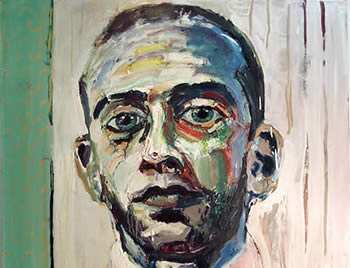Philip Iverson: You Know What They Say About Big Heads
By Evlynne Wa
Philip Iverson’s developed something of a following over the course of the past few years. It’s not a big one, not obsessive enough to be called a ‘cult’, but there are increasing numbers of people drawn to exhibitions and studios by his name. Lucky, then, for the Galerie d’Avignon, which has managed to hook a permanent exhibition of Iverson’s work up in Montreal’s Plateau.
The show itself is a departure not so much from Iverson’s style as from his traditional subject matter – he’s better known for landscapes. Indeed, portraiture isn’t the standard fare of many major Canadian artists working today and Iverson’s take on it – heavily expressionistic as is all his work – is striking.
The pieces’ impact is due to a handful of techniques that Iverson skillfully employs to move his audience. The most obvious of these, to anyone wandering in off the street, is the sheer size of the portraits: many of the show’s pieces are as physically intimidating as they are captivating. The portrait of Alex Katz is five by four foot.
But size alone can’t speak to the whole effect of the show. Other pieces – as striking as the portraits of Katz or Clemente – are no larger than would be expected, but almost seem to climb off the plywood towards you. This effect is the result of Iverson’s skillful rendering of the eyes: they’re larger than they appear in the photographs on which the paintings are based and, as such, give exactly the same efffect as the subject in person. They leer, smile, question and stare, but they cannot be ignored.
Another interesting departure from Iverson’s earlier work is also evident: the restrained, conservative colours. The pieces are mostly black and white – some yellow, and a green or bluish undercoat for the larger ones, but a very limited palette and quite unlike Iverson’s more overtly expressionist landscapes. Most of the subjects themselves are wearing black suits and ties, or else black turtlenecks and t-shirts. Yet despite this restrained colour-scheme the effect is not the least bit dull or gloomy.
One last note: these are paintings of painters – Roy Lichtenstein, George Seagal, Andy Warhol and others – but these are clearly not the artists Iverson takes after. It’s hard to imagine a show that could look less like a Lichteinstein or Warhol exhibition than this. What it is: an homage, on Iverson’s own terms, to artists he admires and respects as the shapers of today’s art culture, as he takes another step toward joining their ranks.

